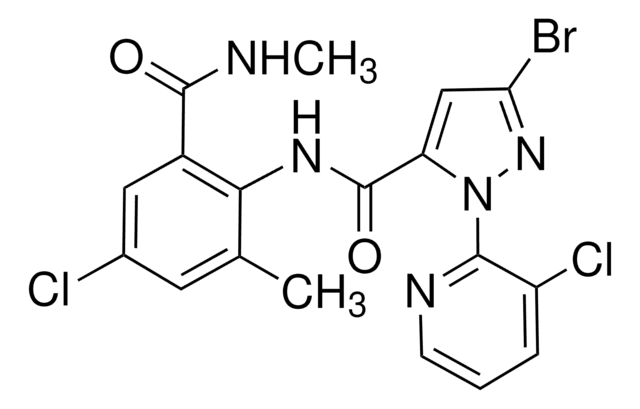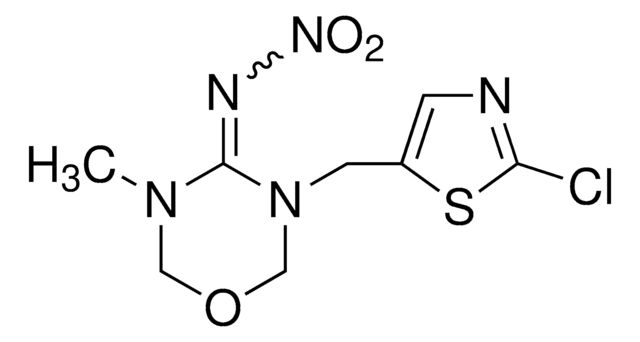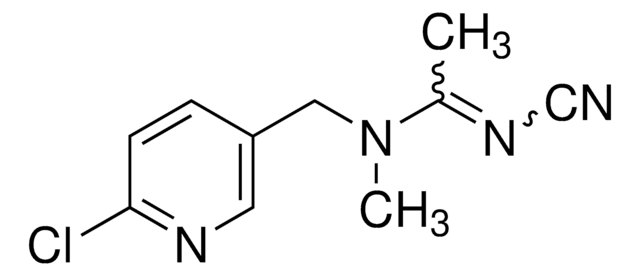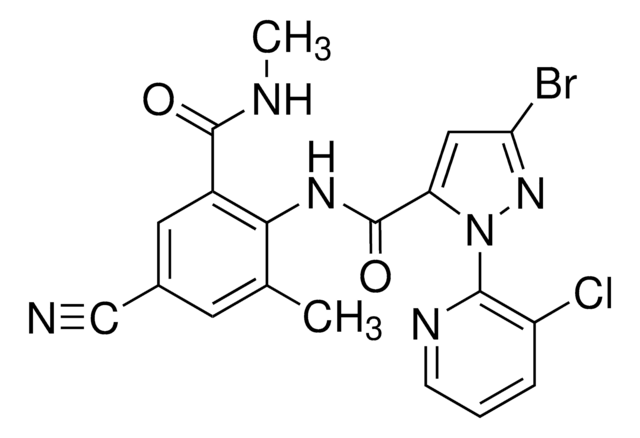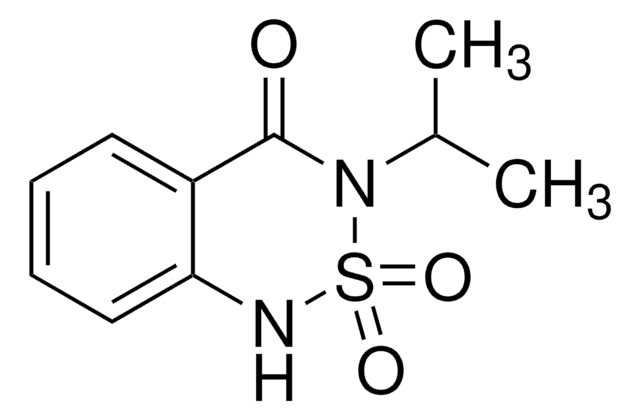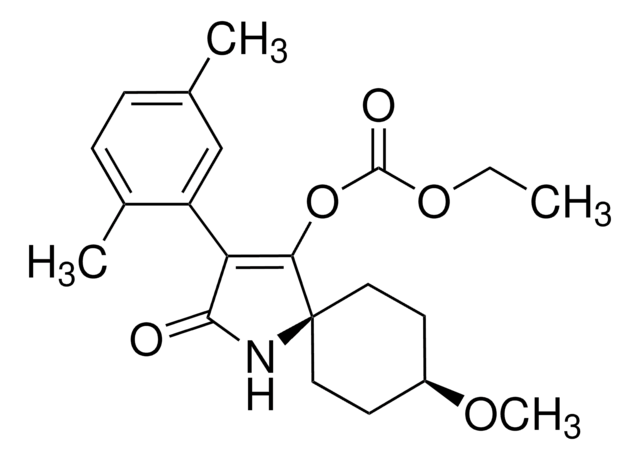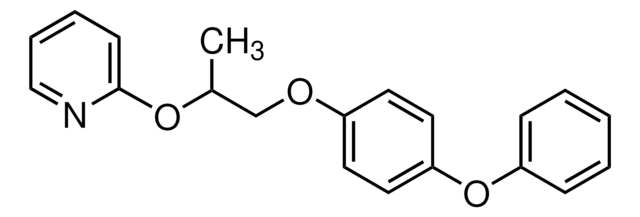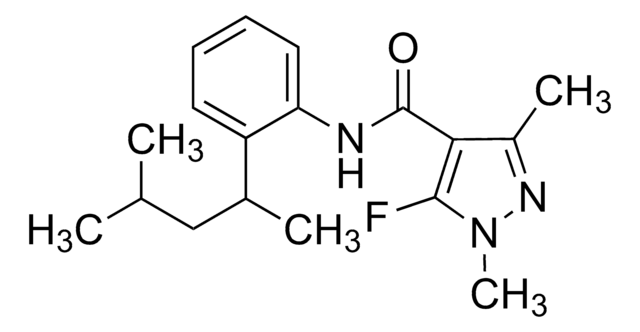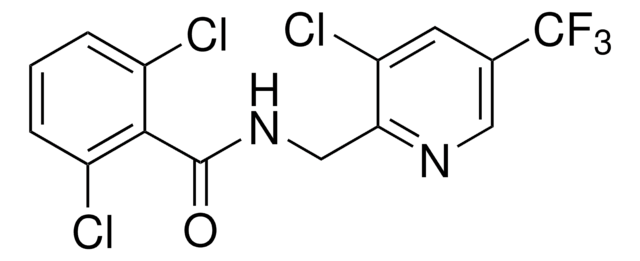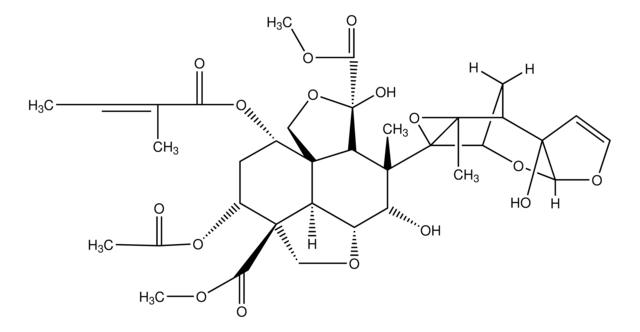32372
Cyantraniliprole
PESTANAL®, analytical standard
동의어(들):
3-Bromo-1-(3-chloro-2-pyridyl)-4′-cyano-2′-methyl-6′-(methylcarbamoyl)pyrazole-5-carboxanilide
로그인조직 및 계약 가격 보기
모든 사진(1)
About This Item
실험식(Hill 표기법):
C19H14BrClN6O2
CAS Number:
Molecular Weight:
473.71
MDL number:
UNSPSC 코드:
77101502
PubChem Substance ID:
NACRES:
NA.24
추천 제품
Grade
analytical standard
Quality Level
제품 라인
PESTANAL®
유통기한
limited shelf life, expiry date on the label
기술
HPLC: suitable
gas chromatography (GC): suitable
응용 분야
agriculture
environmental
형식
neat
SMILES string
O=C(C1=CC(Br)=NN1C2=C(Cl)C=CC=N2)NC3=C(C(NC)=O)C=C(C#N)C=C3C
InChI
1S/C19H14BrClN6O2/c1-10-6-11(9-22)7-12(18(28)23-2)16(10)25-19(29)14-8-15(20)26-27(14)17-13(21)4-3-5-24-17/h3-8H,1-2H3,(H,23,28)(H,25,29)
InChI key
DVBUIBGJRQBEDP-UHFFFAOYSA-N
유사한 제품을 찾으십니까? 방문 제품 비교 안내
일반 설명
Cyantraniliprole an anthranilic diamide, is a second generation ryanodine receptor insecticide. It is widely used to control sucking, chewing and Hemipteran insect pests.
애플리케이션
Cyantraniliprole may be used as a reference standard for the quantification of cyantraniliprole and its metabolites in samples of soil and vegetables by ultra-performance liquid chromatography/tandem mass spectrometry.
Refer to the product′s Certificate of Analysis for more information on a suitable instrument technique. Contact Technical Service for further support.
법적 정보
PESTANAL is a registered trademark of Merck KGaA, Darmstadt, Germany
신호어
Warning
유해 및 위험 성명서
예방조치 성명서
Hazard Classifications
Aquatic Acute 1 - Aquatic Chronic 1
Storage Class Code
11 - Combustible Solids
WGK
WGK 3
Flash Point (°F)
Not applicable
Flash Point (°C)
Not applicable
이미 열람한 고객
Lethal and sublethal effects of cyantraniliprole on Helicoverpa assulta (Lepidoptera: Noctuidae).
Dong J, et al.
Pesticide Biochemistry and Physiology, 136, 58-63 (2017)
Zhihua Qiao et al.
Chemosphere, 236, 124328-124328 (2019-07-17)
Cyantraniliprole is a second-generation diamide insecticide that exhibited excellent biological efficacy against a variety of pests. To assess the toxic impact of cyantraniliprole on earthworms, the levels of reactive oxygen species (ROS) and malondialdehyde (MDA), activities of superoxide dismutase (SOD)
Yayun Zuo et al.
Insect biochemistry and molecular biology, 89, 79-85 (2017-09-16)
Diamide insecticides selectively activate insect ryanodine receptors (RyRs), inducing uncontrolled release of calcium ions, and causing muscle contraction, paralysis and eventually death. The RyR
Jonghwa Lee et al.
Scientific reports, 9(1), 11648-11648 (2019-08-14)
The dissipation patterns of cyantraniliprole and its metabolite IN-J9Z38 were investigated using proso millet (Panicum miliaceum) under open-field conditions to establish a pre-harvest interval. A simple and sensitive analytical method was developed for analyzing residues using ultra-high performance liquid chromatography
Sriyanka Lahiri et al.
Journal of economic entomology, 112(1), 181-187 (2018-10-16)
Thrips are early-season pests of cotton and can cause yield and stand losses if not managed. Strip tillage into a winter cover crop, use of a neonicotinoid seed treatment, and foliar insecticide applications are all reliable pest management tactics, but
자사의 과학자팀은 생명 과학, 재료 과학, 화학 합성, 크로마토그래피, 분석 및 기타 많은 영역을 포함한 모든 과학 분야에 경험이 있습니다..
고객지원팀으로 연락바랍니다.